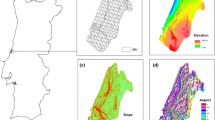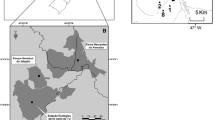Abstract
Fire is widely used in conservation management of native grasslands. Burning is often carried out under conditions that are marginal for sustained fire spread, and therefore it would be useful to be able to predict fire sustainability. There is currently no model allowing such prediction in temperate grasslands. This study aims to identify the environmental variables that determine whether fires will sustain in native grasslands in Tasmania, Australia, and develop a model for predicting fire sustainability in this vegetation. Fuel characteristics and weather conditions were recorded for 111 test fires. Logistic regression modeling identified dead fuel moisture content, fuel load, and percentage dead fuel as predictors of fire sustainability. Classification tree modeling identified dead fuel moisture and fuel load threshold values for sustaining fires. There was also evidence indicating a percentage dead fuel threshold. The logistic regression model and a model combining the results of the classification tree and the percentage dead fuel threshold accurately predicted the outcomes of a small set of experimental fires. These models are likely to have utility in predicting fire sustainability in Tasmanian grasslands and are also likely to be applicable to similar grasslands elsewhere.




Similar content being viewed by others
References
Adamoli J, Sennhauser E, Acero JM (1990) Stress and disturbance—vegetation dynamics in the dry Chaco region of Argentina. Journal of Biogeography 17:491–500
Albini FA (1976) Estimating wildfire behaviour and effects. USDA Forest Service General Technical Report INT-30
Augustin NH, Cummins RP, French DD (2001) Exploring spatial vegetation dynamics using logistic regression and a multinomial logit model. Journal of Applied Ecology 38:991–1006
Beverly JL, Wotton BM (2007) Modelling the probability of sustained flaming: predictive value of fire weather index components compared with observations of site weather and fuel moisture components. International Journal of Wildland Fire 16:161–173
Bond WJ, Archibald S (2003) Confronting complexity: fire policy choices in South African savanna parks. International Journal of Wildland Fire 12:381–389
Briggs JM, Knapp AK (1995) Interannual variability in primary production in tallgrass prairie: climate, soil moisture, topographic position and fire as determinants of aboveground biomass. American Journal of Botany 82:1024–1030
Briggs JM, Knapp AK, Blair JM, Heisler JL, Hoch GA, Lett MS, McCarron JK (2005) An ecosystem in transition: causes and consequences of the conversion of mesic grassland to shrubland. Bioscience 55:243–254
Buchanan AM (2007) A census of the vascular plants of Tasmania. Tasmanian Herbarium, Hobart
Bureau of Meteorology (1981) Observing the weather: the Australian co-operative observer’s guide. Australian Government Printing Service, Canberra
Burrows N, Ward B, Robinson A (1991) Fire behaviour in spinifex fuels on the Gibson Desert Nature Reserve, Western Australia. Journal of Arid Environments 20:189–204
Burrows ND, Ward B, Robinson AD, Behn G (2006). Fuel dynamics and fire behaviour in spinifex grasslands of the western desert. In: Tran C (ed) Life in a fire-prone environment—translating science into practice. Proceedings of the bushfire 2006 conference, 7–9 June 2006, Brisbane, Queensland
Catchpole W (2002) Fire properties and burn patterns in heterogeneous landscapes. In: Bradstock RA, Williams JA, Gill MA (eds) Flammable Australia: the fire regimes and biodiversity of a continent. Cambridge University Press, Cambridge, pp 49–75
Catchpole WR, Catchpole EA (1993) Stratified double sampling of patchy vegetation to estimate biomass. Biometrics 49:295–303
Catchpole WR, Wheeler CJ (1992) Estimating plant biomass: a review of techniques. Australian Journal of Ecology 17:121–131
Cheney NP, Sullivan A (1997) Grassfires: fuel. CSIRO, weather and fire behaviour. Melbourne
Cheney NP, Gould JS, Catchpole WR (1993) The influence of fuel, weather and fire shape variables in fire-spread in grasslands. International Journal of Wildland Fire 3:31–44
Cheney NP, Gould JS, Catchpole WR (1998) Prediction of fire spread in grasslands. International Journal of Wildland Fire 8:1–13
Chuvieco E, Aguado I, Dimitrakopoulos AP (2004) Conversion of fuel moisture content values to ignition potential for integrated fire danger assessment. Canadian Journal of Forest Research 34:2284–2293
de Groot WJ, Wardati WY (2005) Calibrating the fine fuel moisture code for grass ignition potential in Sumatra, Indonesia. International Journal of Wildland Fire 14:161–168
De Luis M, Baeza MJ, Raventós J, González-Hidalgo J (2004) Fuel characteristics and fire behaviour in mature Mediterranean gorse stands. International Journal of Wildland Fire 13:79–87
Diamond J (1986) Overview: laboratory experiments, field experiments and natural experiments. In: Diamond J, Case TJ (eds) Community ecology. Harper and Row, New York, pp 3–22
Fensham RJ (1992) The management implications of fine fuel dynamics in bushlands surrounding Hobart, Tasmania. Journal of Environmental Management 36:301–320
Fernandes PM, Catchpole WR, Rego FC (2000) Shrubland fire behaviour modelling with microplot data. Canadian Journal of Forest Research 30:889–899
Fernandes PM, Botelho H, Rego FC, Loureiro C (2008) Using fuel and weather variables to predict the sustainability of surface fire spread in maritime pine stands. Canadian Journal of Forest Research 38:190–201
Fielding AH, Bell JF (1997) A review of methods for the assessment of prediction errors in conservation presence/absence models. Environmental Conservation 24:38–49
Fuhlendorf SD, Engle DM (2004) Application of the fire—grazing interaction to restore a shifting mosaic on tallgrass prairies. Journal of Applied Ecology 41:604–614
Garvey M, Millie S (2000) Grassland curing guide. Country Fire Authority, Melbourne
Gill AM, Burrows ND, Bradstock RA (1995) Fire modelling and fire weather in an Australian desert. CALM Science Suppplement 4:29–34
Hartley S, Harris R, Lester PJ (2006) Quantifying uncertainty in the potential distribution of an invasive species: climate and the Argentine ant. Ecology Letters 9:1068–1079
Hastie TJ, Tibshirani RJ (1990) Generalized additive models. Chapman and Hall/CRC, Boca Raton, FL
Hosking R (1990) Grassland curing index—a district model that allows forecasting of curing. Mathematical and Computer Modelling 13:73–82
Hosmer DW, Lemeshow S (1989) Applied logistic regression. Wiley, New York
Kirkpatrick JB, McDougall K, Hyde M (1995) Australia’s most threatened ecosystems: the southeastern lowland native grasslands. Surrey Beatty and Sons, Chipping Norton, UK
Knapp EE, Keeley JE (2006) Heterogeneity in fire severity within early season and late season prescribed burns in mixed-conifer forest. International Journal of Wildland Fire 15:37–45
Lacey CJ, Walker J, Noble IR (1982) Fire in Australian tropical savannas. In: Huntley BJ, Walker BH (eds) Ecological studies. Ecology of tropical savannas, vol 42. Springer-Verlag, Berlin, pp 246–272
Lin CC (1999) Modelling the probability of ignition in Taiwan red pine forests. Taiwan Journal of Forest Science 14:339–344
Luke RH, McArthur AG (1978) Bushfires in Australia. CSIRO Division of Forest Research, Canberra
Lunt ID (1997) Effects of long-term vegetation management on remnant grassy forests and anthropogenic native grasslands in south-eastern Australia. Biological Conservation 81:287–297
Luoto M, Hjort J (2005) Evaluation of current statistical approaches for predictive geomorphological mapping. Geomorphology 67:299–315
Marsden-Smedley JB, Catchpole WR (1995) Fire behaviour modelling in Tasmanian buttongrass moorlands. II. Fire behaviour. International Journal of Wildland Fire 5:215–228
Marsden-Smedley JB, Catchpole WR, Pyrke A (2001) Fire modelling in Tasmanian buttongrass moorlands. IV. Sustaining versus non-sustaining fires. International Journal of Wildland Fire 10:255–262
McArthur AG (1966) Weather and grassland fire behaviour. Leaflet No. 100. Forestry and Timber Bureau, Canberra
Morgan JW (1998) Importance of canopy gaps for recruitment of some forbs in Themeda triandra-dominated grasslands in south-eastern Australia. Australian Journal of Botany 46:609–627
Morgan JW (1999) Defining grassland fire events and the response of perennial plants to annual fire in temperate grasslands of south-eastern Australia. Plant Ecology 144:127–144
Parrot RT, McDonald CM (1970) Ignitability of swards of various annual species. Australian Journal of Experimental Agriculture and Animal Husbandry 10:76–83
Paul PM (1969) Field practice in forest fire danger rating. Report FF-X-20. Canadian Forest Service, Forest Fire Research Institute, Ottawa
Plucinski MP (2003) The investigation of factors governing ignition and development of fires in heathland vegetation. Unpublished PhD thesis. University of New South Wales
Purton CM (1982) Equations for the McArthur Mark 4 Grassland Fire Danger Meter. Meteorological Note No. 147. Bureau of Meteorology
R Core Development Team (2007) R: a language and environment for statistical computing. R Foundation for Statistical Computing, Vienna, Austria
Ray D, Nepstad D, Mountinho P (2005) Micrometeorological and canopy controls of fire susceptibility in a forested Amazon landscape. Ecological Applications 15:1664–1678
Ripley B (2007a) Boot: bootstrap R (S-Plus) functions (Canty). http://cran.ms.unimelb.edu.au/. Accessed October 22, 2007
Ripley B (2007b) Tree: classification and regression trees. http://cran.ms.unimelb.edu.au/. Accessed October 22, 2007
Rothermel RC (1972) A mathematical model for predicting fire spread in wildland fuels. Research Paper INT-115. USDA Forest Service
Rothermel RC, Philpot CW (1973) Predicting changes in chaparral flammability. Journal of Forestry 71:640–643
Samson F, Knopf F (1994) Prairie conservation in North America. Bioscience 44:418–421
Savadogo P, Didier Z, Sawadogo L, Tiveau D, Tigabu M, Odén PC (2007) Fuel and fire characteristics in savanna-woodland of West Africa in relation to grazing and dominant grass type. International Journal of Wildland Fire 16:531–539
Scott JH, Burgan RE (2005) Standard fire behavior fuel models: a comprehensive set for use with Rothermel’s surface fire spread model. General Technical Report RMRS-GTR-153. USDA Forest Service
Sing T, Sander O, Beerenwinkel N, Lengauer T (2007) ROCR: visualizing classifier performance in R. Bioinformatics 21:3940–3941
Snyder RL, Spano D, Duce P, Baldocchi D, Xu L, Paw UKT (2006) A fuel dryness index for grassland fire-danger assessment. Agricultural and Forest Meteorology 139:1–11
Streeks TJ, Owens MK, Whiseant SG (2005) Examining fire behaviour in mesquite-acacia shrublands. International Journal of Wildland Fire 14:131–140
Stuwe J, Parsons RF (1977) Themeda australis grasslands on the Basalt Plains, Victoria: floristics and management effects. Australian Journal of Ecology 2:467–476
Tanskanen H, Venäläinen A, Puttonen P, Granstöm A (2005) Impact of stand structure on surface fire ignition potential in southern Finland. Canadian Journal of Forest Research 35:410–420
Thuiller W, Aráujo MB, Lavorel S (2003) Generalized models vs. classification tree analysis: Predicting spatial distributions of plant species at different scales. Journal of Vegetation Science 14:669–680
Tremont RM, McIntyre S (1994) Natural grassy vegetation and native forbs in temperate Australia: structure, dynamics and life histories. Australian Journal of Botany 42:641–658
van Langevelde F, van de Vijver CADM, Kumar L, van de Koppel J, de Ridder N, van Andel J, Skidmore AK, Hearne JW, Stroosnijder L, Bond WJ, Prins HHT, Rietkerk M (2003) Effects of fire and herbivory on the stability of savanna ecosystems. Ecology 84:337–350
Venables WN, Ripley BD (1999) Modern applied statistics with S-Plus. Springer-Verlag, New York
Viney NR (1991) A review of fine fuel moisture modelling. International Journal of Wildland Fire 1:215–234
Weise DR, Zhou X, Sun L, Mahalingam S (2005) Fire spread in chaparral—‘Go or no go?’. International Journal of Wildland Fire 14:99–106
Zhou X, Mahalingam S, Weise D (2005) Modelling marginal burning state of fire spread in live chapparal shrub fuel bed. Combustion and Flame 143:183–198
Acknowledgments
Thanks go to Jon Marsden-Smedley for his invaluable assistance with this project. Thanks are due also to Jenny Styger for her outstanding help in the field and to Jamie Kirkpatrick for his support and guidance. Access to study sites was generously provided by Tom and Cynthia Dunbabin, Allan and John Cameron, and Forestry Tasmania. This project was funded by the Australian Research Council (DPO665083).
Author information
Authors and Affiliations
Corresponding author
Rights and permissions
About this article
Cite this article
Leonard, S. Predicting Sustained Fire Spread in Tasmanian Native Grasslands. Environmental Management 44, 430–440 (2009). https://doi.org/10.1007/s00267-009-9340-6
Received:
Revised:
Accepted:
Published:
Issue Date:
DOI: https://doi.org/10.1007/s00267-009-9340-6




